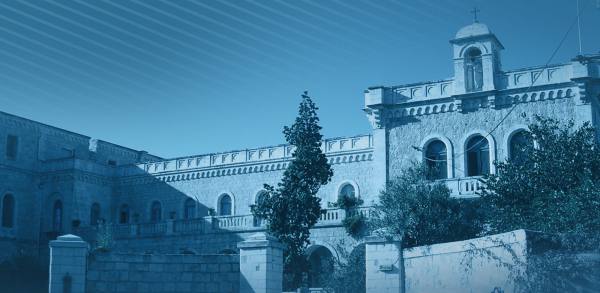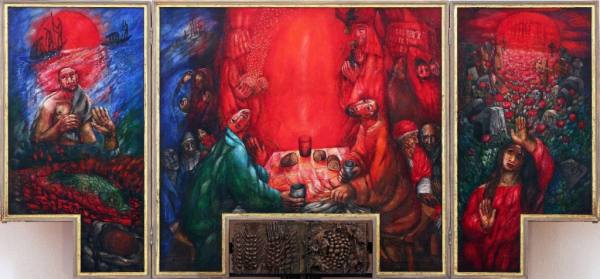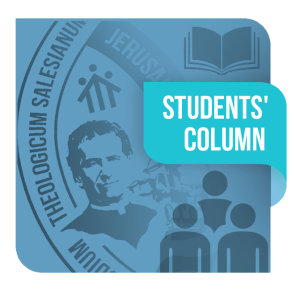In two months, I will be ordained a Catholic Priest with the Salesians of Don Bosco. It has been an 11-year journey of formation and preparation. My grandmother has stopped asking me when I will be ordained because it always seemed like it was years away. Now it is only a matter of months. Traditionally, as part of the preparation, it is common to choose an image and a quote that would be a symbolic representation of this moment of ordination. I will take this opportunity to explain the image I have chosen because I find it to be rich in spiritual and theological content. It is not a typical image and, in fact, it is not something I thought I would choose. Yet I was captivated by it. This painting can be found above the altar in St. Stephen’s Church in Wasseralfingen, Germany, painted by Father Sieger Koder.
St. Peter, on the left, is painted in the water after hearing the insight from St. John; “It is the Lord.” (Jn 21:7) He leaves the disciples in the boat and swims in haste to the Risen Jesus who waits for him on the shore. The hand coming out of the sea symbolizes the event of the walking on the water, when Peter, soon begins to drown the moment he takes his eyes off Jesus. “Lord save me!” (Mt 14:30) This is the hand of surrender, the acknowledgement our weakness, of our need for a Savior. Now, Peter has his eyes fixed on the Lord. There is nothing else. No one is more important. It is the Lord!
On the other side, St. Mary Magdalene, who is face to face with the brightness of the Risen Lord, has her hand opened in the same surrendered prayer after hearing her name pronounced by her Rabbouni. (Jn 20:16) Her life has been a difficult one. Cleansed of seven demons, she knows what it means to suffer. She knows how difficult this world can be. The road behind her is filled with death, injustice, pain and suffering. Yet on this road there is also beauty. Jesus brings the fullness of this reality. We will suffer, we will die but neither of them can have any power over us. Death and suffering are not the last word. The last word is always love. Love conquers even death.
The center piece is a dynamic representation of the disciples on the road to Emmaus who have met the risen Lord in the breaking of the bread. (Lk 24:13-35) Yet another reality is added. This risen Lord is the transfigured One, surrounded on either side by Moses, who receives the manna from Heaven, and Elijah who is sustained by the bread brought by the ravens. The coming together of heaven and earth. The old and the new. The human and the divine. Jesus, the first-born from the dead, the new creation, gives us the new covenant in his very own body and blood. The one disciple is fully immersed, his hand raised in surrendered prayer. Metanoia. Repent and believe in the Good News. (Mk 1:15) The other disciple is still holding on, unwilling to be swept away by the abundant grace freely offered yet necessary for this promised new life of the Kingdom. The two women coming back from the cross are contemplating the stone that separates them from their beloved Friend, Brother and Lord. Who will roll away the stone for us? (Mk 16:3) Even in this tragic moment, their love continues to bind them to Jesus. This love continues to urge them forward in service. They continue to seek him. To ask questions. To desire to be close with him, even in the presence of the painful separation. They will soon realize that he is closer than they could ever imagine.
The three people on the bottom left are said to represent our fallen humanity. The sinner, the tax collector and the prostitute draw near to the warmth and brightness of the Resurrection. Their restless hearts seek a Love that will finally satisfy. On the top right, the window of the Papal apartment is wide open. There is to be no more hiding, no more darkness. It is time to allow the fresh air of the Spirit to move freely, to blow where It will. St. Paul just below has had his life turned upside down. His hand raised in the surrendered prayer that is now common throughout the painting. It is the encounter that changes his life and sends him out on mission. He, at the very core of his being, his very person, becomes a mission on this earth. (Evangelii Gaudium 273) There is nothing left to live for than to preach Christ crucified (1 Cor 1:23), the one who loved him and gave his life for him. (Gal 2:20)
The last of the characters are up for debate. The Pope is most surely St. John XXIII. The older gentlemen according to one description is Pierre Teilhard de Chardin, an influential theologian before Vatican II. However, in my interpretation, the image more closely reflects the person of Jules Isaac, the Jewish historian from France who had a brief but intimate friendship with John XXIII and was very influential in Christian-Jewish relations and an inspiration for the document Nostra Aetate. Jules knew suffering, he knew love, he knew the cross, even if it was hidden within his heart. It is in the context of friendship, even between people of different religions, that will allow each of us to be prepared to encounter the risen Lord.
For me, this entire painting portrays the dynamic life of faith. A faith of beauty and pain. Life and death. Betrayal, forgiveness, surrender, doubt, peace, war, sadness and joy. It is within all of this that we encounter the Risen Lord. It is with our burden and our weakness that He raises us along with his own body. He invites us into his very own passion, death and resurrection. This is the upward calling in Christ Jesus (Phil 3:14). The life of the Spirit towards the Father. All are invited into this Mystery. In my own encounter with the Risen Lord, I have been called to follow him as his priest. I have been called to break the bread, to open up a space for an encounter with Him. It is not my priesthood. It is HIS. My hands, lifted in surrendered prayer, must always be ready to do the will of the Father. To allow his love to move me to action. To listen as he calls my name, day after day, accompanying me as I carry the cross I have been given. Yet, the cross is not a symbol of death, but of unconditional and total love given freely. This love transforms. This love offers us the gift of becoming partakers in the divine nature. (2 Peter 1:4) I am not yet sure what I shall be, but when it is revealed, I do know that I will be like him, for I shall see him as he is. (1 Jn 3:2). The call is to abide; to abide in Love; to abide in the great Mystery of Faith and as we abide, we become. May our hearts be surrendered and may we enter into his glory. (Lk 24:26)
- Steve Demaio SDB
May 26, 2021



GREAT, picture from Sieger Koeder. So the “painting priest” and his paintings are famous also in other countries than Germany? Love it!
Wishing you, dear Brother Steve, a colorful priesthood as in these paintings! Sr. M. Gabriela
Thank you Steve for this beautiful reflection and painting which carries so much of what the Lord has planted in your heart. You are a Salesian Priest forever. There are many who await the Lord through you – be that Eucharist and compassion who will receive him from you, receive His forgoveness and mercy through you and feel in presence in your eyes and healing touch. The young await you as Shepherd like Don Bosco. Do not fear Mary Help will guide you. Steve Shafran
Father Steve, thank you so much with his deep and beautiful reflection on our life with God and the Mystery of our love and it’s suffering for that love ademption of all and the glory of God.
I am deeply grateful for you. Are you going Holiness each day in the image and likeness of Jesus as Savior. With the help of Christians st. John Bosco Saint Joseph and all the saints St Francis de Sales stay with you do you reach that goal the heaven but God wants all of us to be amen. Gratefully, Brother Sal